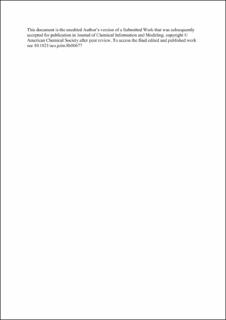Hit Dexter 2.0: Machine-Learning Models for the Prediction of Frequent Hitters
Journal article, Peer reviewed
Accepted version
Permanent lenke
https://hdl.handle.net/11250/2738716Utgivelsesdato
2019Metadata
Vis full innførselSamlinger
- Department of Chemistry [433]
- Registrations from Cristin [9791]
Originalversjon
Journal of Chemical Information and Modeling. 2019, 59 (3), 1030–1043. 10.1021/acs.jcim.8b00677Sammendrag
Assay interference caused by small molecules continues to pose a significant challenge for early drug discovery. A number of rule-based and similarity-based approaches have been derived that allow the flagging of potentially “badly behaving compounds”, “bad actors”, or “nuisance compounds”. These compounds are typically aggregators, reactive compounds, and/or pan-assay interference compounds (PAINS), and many of them are frequent hitters. Hit Dexter is a recently introduced machine learning approach that predicts frequent hitters independent of the underlying physicochemical mechanisms (including also the binding of compounds based on “privileged scaffolds” to multiple binding sites). Here we report on the development of a second generation of machine learning models which now covers both primary screening assays and confirmatory dose–response assays. Protein sequence clustering was newly introduced to minimize the overrepresentation of structurally and functionally related proteins. The models correctly classified compounds of large independent test sets as (highly) promiscuous or nonpromiscuous with Matthews correlation coefficient (MCC) values of up to 0.64 and area under the receiver operating characteristic curve (AUC) values of up to 0.96. The models were also utilized to characterize sets of compounds with specific biological and physicochemical properties, such as dark chemical matter, aggregators, compounds from a high-throughput screening library, drug-like compounds, approved drugs, potential PAINS, and natural products. Among the most interesting outcomes is that the new Hit Dexter models predict the presence of large fractions of (highly) promiscuous compounds among approved drugs. Importantly, predictions of the individual Hit Dexter models are generally in good agreement and consistent with those of Badapple, an established statistical model for the prediction of frequent hitters. The new Hit Dexter 2.0 web service, available at http://hitdexter2.zbh.uni-hamburg.de, not only provides user-friendly access to all machine learning models presented in this work but also to similarity-based methods for the prediction of aggregators and dark chemical matter as well as a comprehensive collection of available rule sets for flagging frequent hitters and compounds including undesired substructures.
